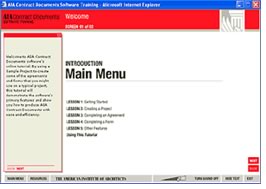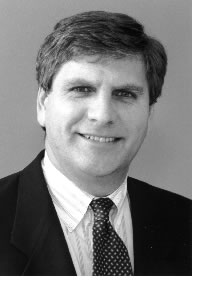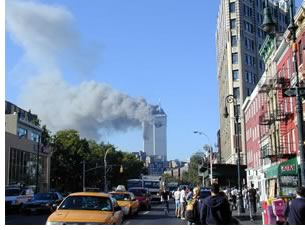

04/2005
Due to popular demand, the AIA has added some exciting new continuing education opportunities to the roster of the AIA National Convention in Las Vegas, May 19–21.
 Preconvention workshop
Preconvention workshop
WE30 Introduction to AIA Contract Documents Software, Wednesday, May
18, 9:00 a.m.–4:30 p.m. (entry level, 6 LUs, $170)
This is an off-site workshop to be completed in a “computer lab,” location
to be determined. See the final Program when you arrive for location.
Join this hands-on, interactive introduction to AIA Contract Documents
software and gain working knowledge of the software and its functionality.
Topics include navigating through the software, completing dialogues,
importing data, editing and finalizing agreements and project administration
forms, and collaborating with colleagues. Create a custom AIA contract
document template, explore the help menu, and test your knowledge and
skills by creating core documents for a typical project.
The learning objectives for this class include: discovering how the project management and collaboration features of the AIA Contract Documents software can support your practice; using the software’s core functions to create, generate, and finalize agreements and forms; and exploring additional advanced software features and options, short-cut tricks, and help resources. Sign up now if you want to take this class provided by AIA Contract Documents and AIA Continuing Education: it is limited to 32 participants.
 FR57 Compensation Challenges and Strategies
in an Improving Economy, Friday, May 20, 4–5:30 p.m. (intermediate
to advanced level)
FR57 Compensation Challenges and Strategies
in an Improving Economy, Friday, May 20, 4–5:30 p.m. (intermediate
to advanced level)
Compensation at design firms traditionally has been closely linked to
the health of the construction economy. In the late 1990s, architect
compensation increased dramatically, while growing much more slowly during
the early part of this decade as the economy faltered.
Are we currently in a seller’s market or a buyer’s market? What advantages can smaller or larger firms offer to make their positions more attractive? With what compensation realities must our profession come to grips to ensure success over the coming decade? Using a preview of the 2005 AIA Compensation Report as a backdrop, this session will discuss compensation challenges and strategies designed to attract qualified new staff and retain valued current employees.
Learning objectives for this seminar include identifying compensation challenges at architecture firms, evaluating adequacy of compensation and benefit programs, and developing strategies to ensure future firm stability in staffing. Join AIA Chief Economist Kermit Baker, PhD, Hon. AIA, plus panelists Meg Brown, of Perkins + Will; Diego Saltes, the AIA’s director of economics and research; and Robert P. Smith, AIA, of Culpepper, McAuliffe and Meaders Inc., for this program provided by the AIA Continuing Education team.
 FR60 The Planning and Design of the New
York City 2012 Olympics, Friday, May 20, 8:15–9:45 a.m. (intermediate
level)
FR60 The Planning and Design of the New
York City 2012 Olympics, Friday, May 20, 8:15–9:45 a.m. (intermediate
level)
New York City is one of five cities vying to host the 2012 Summer Games.
(The other cities are London, Paris, Madrid, and Moscow.) NYC2012, the
city’s Olympic Bid Committee, has worked with architects, urban planners,
and athletes to devise an innovative plan—the “Olympic X”—for
holding the games in the Big Apple. This plan addresses the challenges
of incorporating Olympic and Paralympic requirements for 23,500 athletes,
30,000 media, and 11.8 million ticketed spectators. The centerpiece of
the plan is the Olympic Village, designed by Morphosis’ Thom Mayne,
FAIA, recipient of the 2005 Pritzker Architecture Prize. The Olympic
Village and the other planned venues have been carefully integrated into
the city’s long-term planning strategy, which includes expansion of the
central business districts, revitalization of the waterfront, and the
sustainable development of new parks and multipurpose facilities.
Learning objectives for this seminar derive from exploring the “Olympic X” plan and conceptual design of proposed venues; presentation of the design, concept, and workings of the Olympic Village; and reviewing how the plan was developed and integrated into the city’s long-term planning strategy. Join Mayne and Scott Raphael Schiamberg, AIA, of NYC2012, for this seminar provided by AIA New York and NYC2012.
 FR39 Lessons from the World Trade Center—NEW,
Friday, May 20, 1:30–3:00 p.m. (entry to advanced level)
FR39 Lessons from the World Trade Center—NEW,
Friday, May 20, 1:30–3:00 p.m. (entry to advanced level)
The NIST investigation into the cause of the 2001 collapse of the World
Trade Center buildings, and the background research that is an integral
part of resulting report, will advance the study of buildings and building
science. This program will outline many of the issues examined in the
investigation process. Architects can benefit from understanding the
impact that design can have on safety.
Learning objectives for this seminar involve analyzing the impact of fire protection and its performance as part of a building structure; exploring possible ways in which practice will change, given the findings related to human behavior and performance during a disaster; and considering the needs of responders to an emergency and the impediments they generally face when a building is on fire. Join Shyam Sunder, of the National Institute of Standards and Technology Building and Fire Research Laboratory, and Kathleen J. Tierney, of the University of Colorado at Boulder Institute of Behavioral Science, for this program presented by the AIA Code Advocacy Program.
 FR56
Stairsteps to the Gods: Design/Construction of the Great Pyramid, Friday,
May 20, 4:00–5:30 p.m. (entry to advanced
level)
FR56
Stairsteps to the Gods: Design/Construction of the Great Pyramid, Friday,
May 20, 4:00–5:30 p.m. (entry to advanced
level)
No monument to human achievement has intrigued people more than the Great
Pyramid. This most celebrated and enduring vestige of the remarkable
civilization that emerged during the golden age of the pharaohs is a
structure without equal. Craig Smith, a highly regarded program manager
with considerable expertise in managing large construction projects in
both technologically advanced and developing countries, began his analysis
of the Great Pyramid’s construction by approaching the project as a program
manager might have in 2550 B.C. His presentation offers a fascinating
forensic analysis of how one of the world’s greatest construction projects
was accomplished more than 4,000 years ago.
Learning objectives for this course include examining design techniques used by the ancient Egyptians, discussing scheduling and project controls, and describing program management methodology. Join providers Craig B. Smith, PhD, and AIA Continuing Education for this fascinating seminar.
 SA19 MGM Mirage’s Project CityCenter,
Saturday, May 21, 8:15–9:45 a.m. (intermediate level)
SA19 MGM Mirage’s Project CityCenter,
Saturday, May 21, 8:15–9:45 a.m. (intermediate level)
MGM Mirage’s Project City Center, to be built along the famous
Las Vegas Strip, confirms a cultural and lifestyle revival of central
city living. The presentation will focus on this groundbreaking design,
which introduces a dazzling vertical city to the heart of Las
Vegas’s
sprawling horizontal grid. Architect Ehrenkrantz, Eckstut & Kuhn
addressed the design challenge of combining the ultra-contemporary needs
of technology and life-style with tried-and-true urban traditions to
create a “city” of
high-density, mixed-use buildings and public places. The pedestrian-friendly
environment offers rooftop garden oases forming a contiguous park system,
and also strives to be convenient for cars.
Learning objectives for this seminar include reviewing the design of large, complex, mixed-use urban developments; discussing creation of urban residential, high density, multilevel environments; and discovering the benefits of roof gardens. Join Peter David Cavaluzzi, FAIA, and Stanton Eckstut, FAIA, of Ehrenkrantz, Eckstut & Kuhn Architects for this seminar provided by their firm and AIA Continuing Education.
Copyright 2005 The American Institute of Architects.
All rights reserved. Home Page ![]()
![]()
 |
||
For more
about the convention, or to register, visit the AIA National Convention
and Design Exposition Web site.
|
||